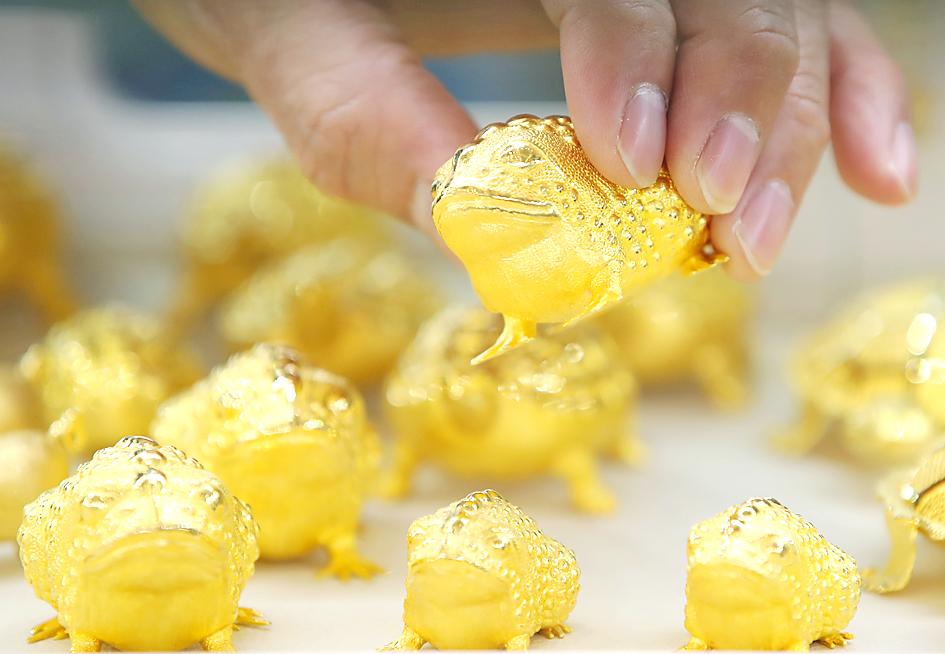Gold began the year with lofty expectations on the back of a record high and its biggest annual gain in a decade. Instead, the precious metal is off to its worst start in 30 years.
Spot prices on Friday touched a seven-month low before erasing losses as the US dollar moved lower, although bullion is already down more than 6 percent this year.
The metal, which surged last year on pandemic-induced haven buying, low interest rates and stimulus spending, is now this year’s’s worst performer in the Bloomberg Commodity Index.

Photo: EPA-EFE
It is suddenly facing a host of unexpected stumbling blocks. Chief among those are the surprising resilience in the US dollar and a rally in USTreasury yields, as economic indicators show recovery from the COVID-19 pandemic is well under way.
With “rates going higher and inflation expectations peaking out, we’re seeing a lot of profit-taking in gold, and people are going from gold into industrial metals such as copper,” said Peter Thomas, senior vice president at Zaner Group in Chicago. “It’s a perfect storm.”
Through Thursday, gold’s start to the year was the worst since 1991, data compiled by Bloomberg showed.
A gain in US Treasury yields is weighing on demand for non-interest-bearing bullion, with the metal extending losses after forming a so-called death-cross pattern earlier this week. Yields on 10-year Treasuries climbed to the highest level in about a year this week.
Inflation expectations have also climbed, with 10-year US breakevens touching the highest since 2014 earlier this week.
Still, that might not be as supportive for gold as it typically would be, Julius Baer Group Ltd analyst Carsten Menke said.
A “rapid recovery will inevitably lead to higher inflation. This should not be positive for gold as it is a good kind of inflation, reflecting an acceleration of economic activity, and not a bad kind of inflation, signaling a loss of trust in the US dollar,” he said in a note.
The economic recovery should prompt investors to sell some of their holdings of the haven, he said.
There are signs that is already happening, with holdings in gold-backed exchange-traded funds falling to the lowest since July, data compiled by Bloomberg showed.
Holdings are down about 1 percent this year and sustained outflows could prove a serious headwind.
Spot gold was down 0.38 percent at US$1,782.2367 an ounce. Futures for April delivery on the Comex rose 0.1 percent to settle at US$1,777.40 an ounce.
Still, some see prospects for gold to make a comeback, betting that the inability of governments and central banks to normalize stimulus policy will support the metal.
Goldman Sachs Group Inc said in late January that with prospects for additional stimulus and US Federal Reserve interest rates on hold, the metal “remains a compelling investment for the medium-to long-term investor.”
“For us, the behavior of gold at the moment resembles that of a tsunami: In the first phase, the water recedes (the gold price falls), and then in the second phase it comes back all the more violently,” Commerzbank AG analyst Daniel Briesemann said. “At the end of the year, we now see gold at US$2,000 per ounce.”
Additional reporting by Reuters

Intel Corp chief executive officer Lip-Bu Tan (陳立武) is expected to meet with Taiwanese suppliers next month in conjunction with the opening of the Computex Taipei trade show, supply chain sources said on Monday. The visit, the first for Tan to Taiwan since assuming his new post last month, would be aimed at enhancing Intel’s ties with suppliers in Taiwan as he attempts to help turn around the struggling US chipmaker, the sources said. Tan is to hold a banquet to celebrate Intel’s 40-year presence in Taiwan before Computex opens on May 20 and invite dozens of Taiwanese suppliers to exchange views

Application-specific integrated circuit designer Faraday Technology Corp (智原) yesterday said that although revenue this quarter would decline 30 percent from last quarter, it retained its full-year forecast of revenue growth of 100 percent. The company attributed the quarterly drop to a slowdown in customers’ production of chips using Faraday’s advanced packaging technology. The company is still confident about its revenue growth this year, given its strong “design-win” — or the projects it won to help customers design their chips, Faraday president Steve Wang (王國雍) told an online earnings conference. “The design-win this year is better than we expected. We believe we will win

Chizuko Kimura has become the first female sushi chef in the world to win a Michelin star, fulfilling a promise she made to her dying husband to continue his legacy. The 54-year-old Japanese chef regained the Michelin star her late husband, Shunei Kimura, won three years ago for their Sushi Shunei restaurant in Paris. For Shunei Kimura, the star was a dream come true. However, the joy was short-lived. He died from cancer just three months later in June 2022. He was 65. The following year, the restaurant in the heart of Montmartre lost its star rating. Chizuko Kimura insisted that the new star is still down

While China’s leaders use their economic and political might to fight US President Donald Trump’s trade war “to the end,” its army of social media soldiers are embarking on a more humorous campaign online. Trump’s tariff blitz has seen Washington and Beijing impose eye-watering duties on imports from the other, fanning a standoff between the economic superpowers that has sparked global recession fears and sent markets into a tailspin. Trump says his policy is a response to years of being “ripped off” by other countries and aims to bring manufacturing to the US, forcing companies to employ US workers. However, China’s online warriors